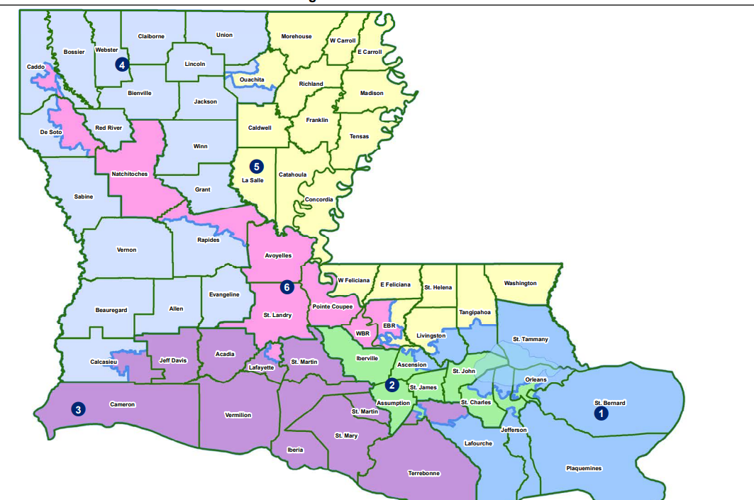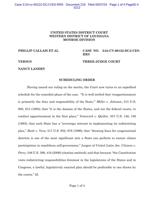Louisiana’s six U.S. House members still don’t know the shape of the districts they’ll run for this fall. But that should clarify within a month, according to an order promulgated Tuesday by the panel of three federal judges overseeing the complex dispute.
The judges ordered the various parties in the redistricting litigation to submit proposed election maps by May 17. Each of the litigants – some of whom want to keep a version of the present configuration, which has elected five White Republican representatives and one Black Democrat, and others seeking two majority-Black congressional districts – will be limited to one map apiece.
The order doesn't take a position on how many majority-Black districts there should be. It just says that each proposal must include evidence and argument supporting how their map best elects representatives under the criteria set under the Voting Rights Act of 1965.
On May 24, the parties will file responses to the other proposals. The three judges will hold a hearing on May 30 in the Lafayette federal courthouse. A decision is expected by June 4.
The timeline the panel laid out ignores a plea from Secretary of State Nancy Landry, who argued that her office needed final maps by May 15 in order to properly stage the election. Landry noted that the election will also include the presidential race and is thus likely to attract far more voters than a typical election.
The court noted that the state had argued in a related redistricting case that it could live with a decision on the maps until the end of May.
State legislatures are supposed to get first crack at drawing redistricted maps. The panel's order nodded in that direction but didn't give Louisiana lawmakers much time: A special session, which could be called while legislators are still in session, could not start for at least seven days until after it's called.
When asked Tuesday if he would call a special session, Gov. Jeff Landry said: “I’m going to try to figure out exactly what we could do right now.”
“If the Louisiana Legislature fails to enact a new map by June 3, 2024, the Court intends to order the use of an interim remedial Congressional districting map on June 4,” the scheduling order states. The panel may employ a “technical adviser.”
State Senate President Cameron Henry, R-Metairie, said the judicial timeline would make drawing a new map impossible for state lawmakers.
State Rep. Kyle Green, a Marrero Democrat who has been following the litigation closely, said: “Based on the panel’s scheduling order, it appears the panel is poised to implement its own remedial map.”
Attorney General Liz Murrill filed a notice that the state would appeal to the U.S. Supreme Court.
“Today, three federal judges who never spent a day running an election have ignored uncontradicted testimony that we need a map by May 15, and once again turned Louisiana’s Congressional elections upside down," Murrill said in a prepared statement. "That’s on the tails of another federal judge, the 5th Circuit, and the Supreme Court doing it in the last round of Congressional elections."
The panel was selected by the chief judge of the 5th U.S. Circuit Court of Appeals and includes 5th Circuit Judge Carl E. Stewart, of Shreveport, who was nominated to the bench by President Bill Clinton, along with U.S. District Court Judges Robert R. Summerhays and David C. Joseph, both of whom were chosen by President Donald Trump and sit in Lafayette.
Summerhays and Joseph last week rejected the congressional election map the Legislature adopted in January, which would have created two minority-majority districts. The decision left the state without any maps in force.
Virtually all the parties have appealed or plan to appeal the panel’s decision to the Supreme Court. Whether the top court will intervene is still unknown.
Summerhays and Joseph found that the Legislature’s January map relied too heavily on race and not enough on traditional redistricting principles, such as geographic compactness of residents with similar interests, that are required by the Voting Rights Act.
Stewart countered that the majority discounted the evidence that showed politics weighed as heavily as race in the drafting of the two minority-majority districts. The new map was designed in part to punish U.S. Rep. Garret Graves, R-Baton Rouge, who has made several prominent enemies in his own party, according to testimony in the case.
Black residents now compose about a third of Louisiana’s 4.7 million people, and advocates have argued that two of the six congressional districts should be drawn to favor Black candidates.
Chief U.S. District Judge Shelly Dick, of Baton Rouge, agreed in 2022 and found that Louisiana's Black population lived close enough together that a second minority-majority district could be drawn. Two similar federal judge panels did not object to her opinion.
The Legislature, fearing a federal judge would draft the maps, in January created a map with two Black-majority districts. Their version ensured House Speaker Mike Johnson, R-Benton, and House Majority Leader Steve Scalise, R-Jefferson, the chamber’s two top leaders, would see few changes to their districts. The Legislature also wanted to protect Rep. Julia Letlow, R-Start, the delegation’s only woman and only member of the House Appropriations Committee, which decides how federal dollars are spent.
That left Graves to run in a newly created Black majority district that linked predominantly Black neighborhoods in Baton Rouge, Lafayette, Alexandria and Shreveport. A dozen “non-Black” voters challenged the Legislature’s map arguing that it was a racial gerrymander.
Tyler Bridges and James Finn of the Capitol news bureau contributed to this report.



